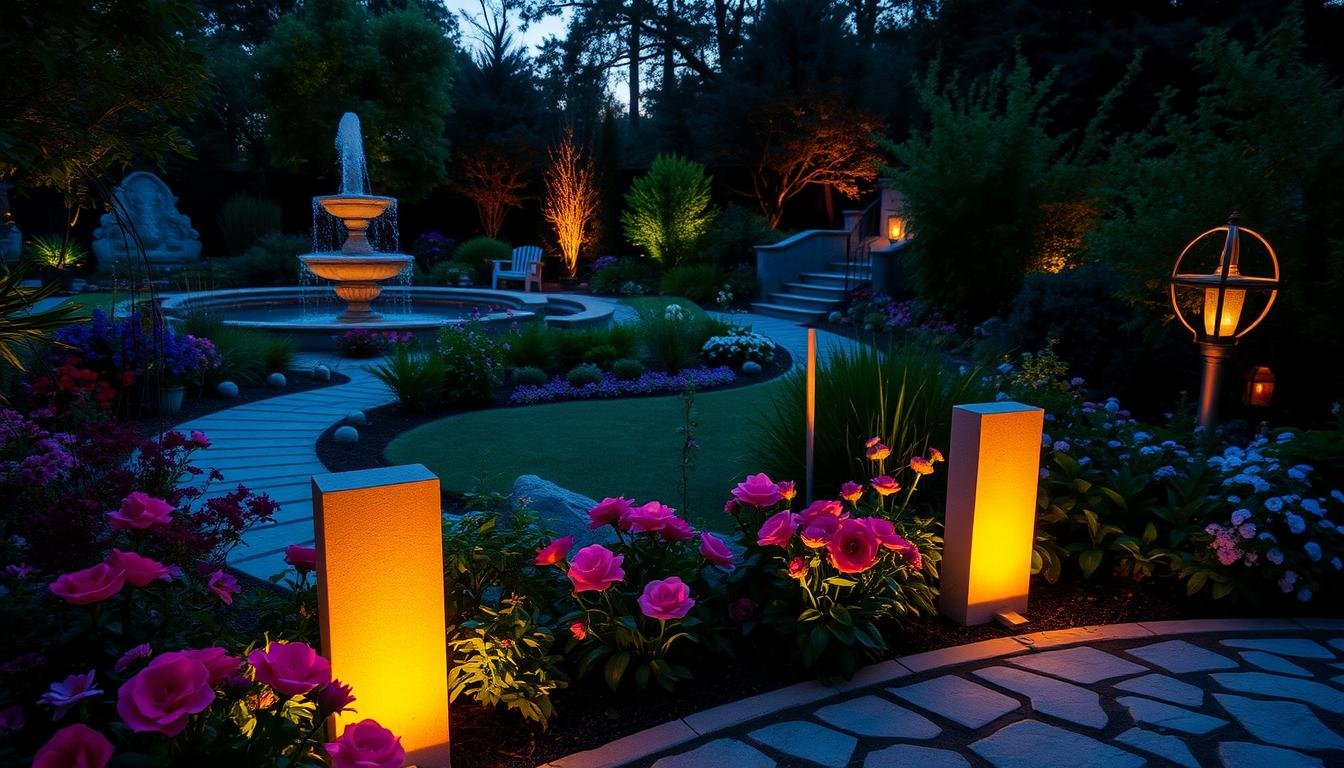Some links on this page are affiliate links. This means we may earn a commission at no additional cost to you if you click through and make a purchase. Thank you for your support!
As I step into my garden, I always look for ways to make it shine. I wonder, what’s the best way to use spotlights to highlight my garden’s unique features? Spotlights can greatly enhance the beauty and safety of outdoor spaces. With the right garden lighting tips, you can create a stunning outdoor oasis for relaxation and entertainment.
When choosing outdoor spotlight ideas, consider the types of spotlights, light intensity, and beam spread. LED spotlights, for example, have narrower beam angles than LED floodlights. This makes them perfect for highlighting specific features in landscaping. By picking the right spotlights and using them well, you can create a beautiful and inviting outdoor space that showcases your garden’s best features.
Understanding Garden Spotlight Basics
Exploring garden spotlighting, I want to share key elements for a stunning outdoor space. It’s about showing off your garden’s beauty. You’ll find various spotlights, like fixed and adjustable ones, each with special features.
Light intensity and beam spread are key. The right light can change your garden’s feel. A narrow beam is good for focusing on certain spots. A wider beam is better for lighting up bigger areas.
When it comes to power, you can choose solar or low-voltage spotlights. Solar ones save energy and money, making them popular. Low-voltage ones are safe and simple to set up, perfect for DIY fans.
- Fixed spotlights: Great for highlighting specific features like trees or statues.
- Adjustable spotlights: Ideal for directing light to different areas of the garden.
- Solar-powered spotlights: Energy-efficient and cost-effective.
- Low-voltage spotlights: Safe and easy to install.
Knowing these basics will help you create a beautiful outdoor space. It’s a place you’ll love for many years.
Essential Tools and Materials for Garden Lighting
When I plan my garden lighting, I think about what I need to make it happen. I look at garden lighting tools like spotlights. They come in many styles and finishes to match any garden.
I also consider the materials. I want them to last long and not rust. Plus, they should look good in my garden.
For a garden lighting system, I need cables and connectors that can handle the weather. I decide on the type of spotlights I want. This could be for lighting up plants, downlighting, or just adding highlights.
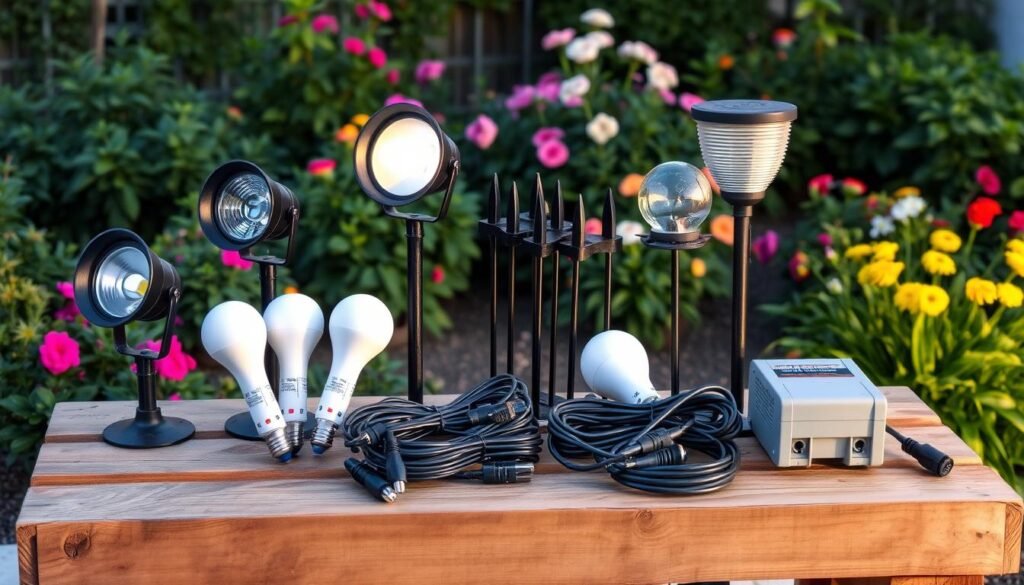
- Garden lighting tools like spotlights and transformers
- Weather-resistant cables and connectors
- Durable materials like cast aluminum or stainless steel
- Energy-efficient options like LED bulbs
By picking the right tools and materials, I can make a beautiful garden lighting system. It will make my outdoor space even more stunning.
Strategic Placement of Spotlights to Highlight Garden Features
When I think about lighting up my garden, I focus on spotlight placement. Placing spotlights in key spots can turn certain areas into focal points. This draws eyes to specific parts of my garden.
Using layering light effects is another smart move. It means mixing different lights to make a beautiful scene. Spotlights, path lights, and string lights can all be used to layer the light.
To make my spotlights work best, I need to think about distance and angle calculations. I figure out the right spot and angle for each light. This way, I can make sure each light shines on the right feature. It creates a stunning effect that shows off my garden’s best spots.
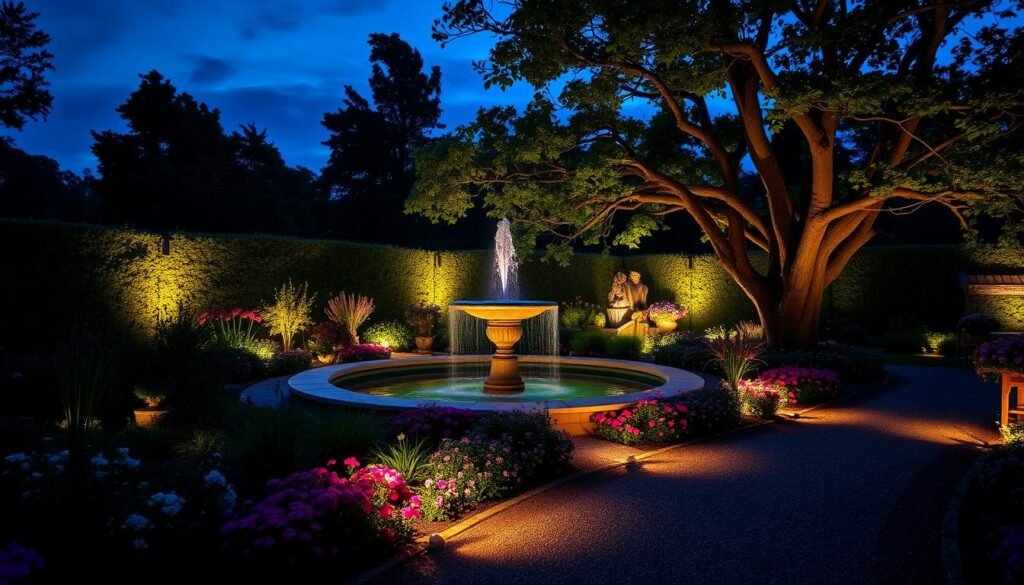
- Using spotlights to create focal points, such as highlighting a statue or water feature
- Layering light effects to create a unique and visually appealing atmosphere
- Calculating distance and angle to ensure that each spotlight is shining on the desired feature
By using these tips and placing spotlights wisely, I can make my garden a cozy and welcoming place. It’s perfect for unwinding or hosting guests.
Illuminating Different Garden Elements
When I look at my garden, I think about how tree and shrub lighting can make them shine. Spotlights can highlight these features, making my garden welcoming. For instance, I use directional LED spotlights to show off my trees and shrubs’ texture and depth at night.
Spotlights also enhance flower beds. By placing them near my flower beds, I can make the colors and shapes pop. This makes my flowers a key part of my garden’s look. Water features get a spotlight too, adding to the garden’s ambiance, whether it’s a small pond or a big fountain.
Garden art and sculpture lighting add interest to my garden. It draws attention to certain pieces, creating drama. Here are some ideas for lighting garden art and sculptures:
- Spotlighting a beautiful statue or sculpture
- Lighting near a water feature to show movement and flow
- Using string lights for a whimsical touch
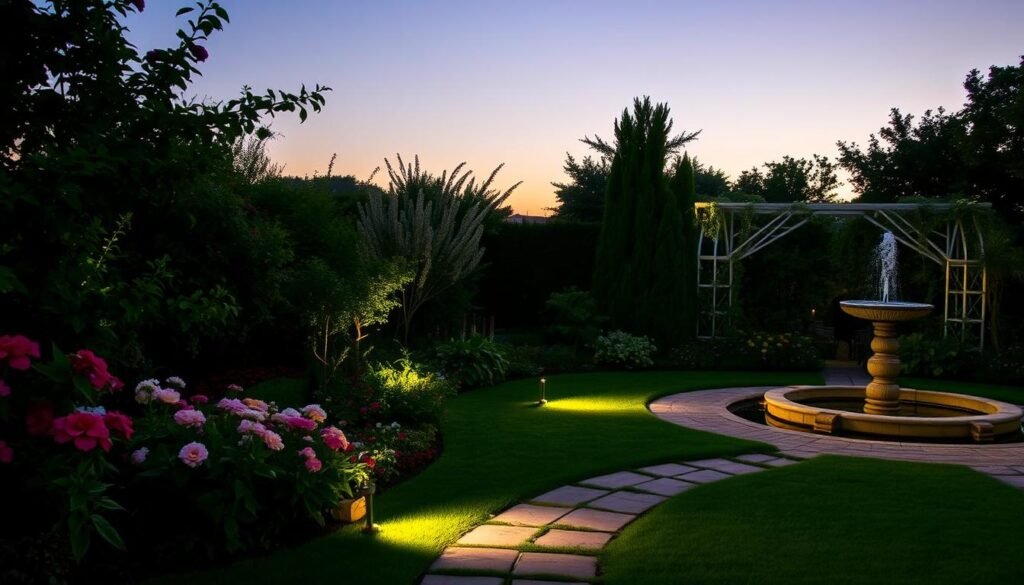
By adding these lighting types to my garden, I create a beautiful space. It’s a place I can enjoy for many years.
Professional Techniques for Dramatic Effects
Exploring garden lighting design, I found that using professional techniques can greatly enhance dramatic effects. By layering lights, you can create a stunning environment that showcases your garden’s beauty. A mix of uplighting, downlighting, and path lighting can highlight different aspects of your landscape.
Techniques like moonlighting and graze lighting are key. Moonlighting uses lights in trees to mimic the moon’s glow. Graze lighting, by placing lights near surfaces, brings out textures and architectural details. These methods can add a serene feel and highlight your garden’s features.
Here are some tips for dramatic garden effects:
- Use a mix of light intensities to avoid glare and enhance visual interest
- Highlight focal points and create visual interest through techniques like uplighting and downlighting
- Consider using LED lights, which are energy-efficient and have a longer lifespan than traditional bulbs
By applying these techniques, your garden lighting can become stunning and dramatic. Always consult with a professional landscape lighting company for the best placement and effects. This ensures your investment is worth it and minimizes risks.
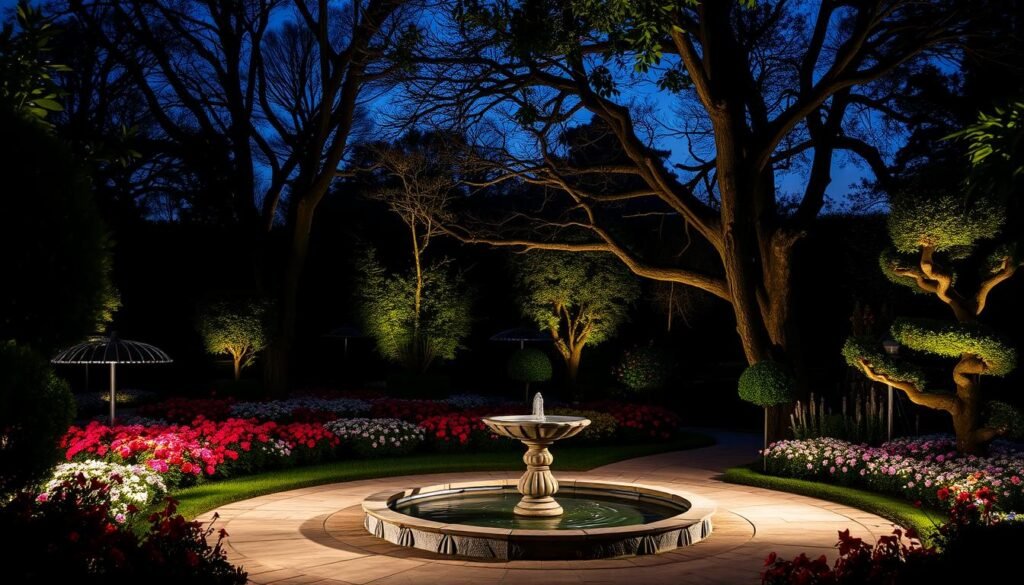
| Lighting Technique | Description |
|---|---|
| Uplighting | Used to showcase plant shapes and foliage, for taller hardscape structures or plants |
| Downlighting | Creates a beautifully lit garden or landscape, blending techniques seamlessly |
| Path Lighting | Serves both aesthetic and safety purposes, illuminating walkways, curbside flowers, and ornamental grasses |
Weather-Resistant Installation Methods
When I plan my garden lighting, I think about how to keep it safe and working well in all kinds of weather. I make sure to protect my fixtures from moisture and corrosion. I also manage cables to avoid damage and adjust my setup for each season.
I choose high-quality, weather-resistant materials like stainless steel or powder-coated aluminum for my lights. I also check that my lights have a high IP rating, like IP65. This means they can handle heavy rains and dusty conditions without losing their shine.
Some important things to keep in mind for weather-resistant installation are:
- Using rust-proof coatings on fixtures to keep them working well for a long time
- Keeping cables safe from moisture, corrosion, or UV damage
- Adjusting my setup for each season to keep my garden lights running smoothly
By following these tips and using weather-resistant methods, I can make a garden lighting system that lasts. It will light up my outdoor space beautifully, no matter the weather.
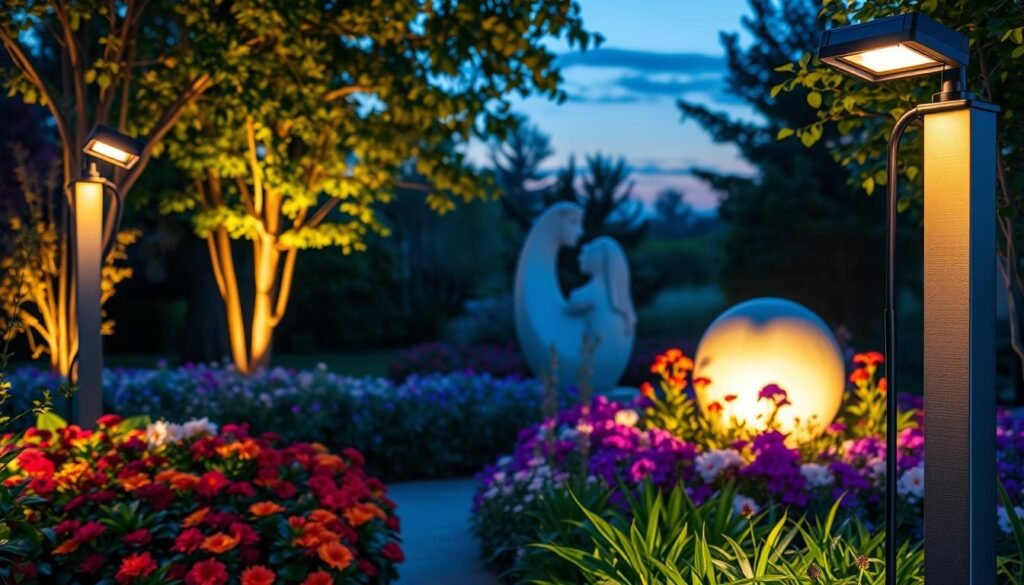
| Material | IP Rating | Benefits |
|---|---|---|
| Stainless Steel | IP65 | Corrosion-resistant, durable, and low maintenance |
| Powder-Coated Aluminum | IP65 | Weather-resistant, rust-proof, and energy-efficient |
Energy-Efficient Spotlight Solutions
When picking out garden lights, I look for energy-efficient spotlights. They help the planet and cut down my electricity bills. LED technology is a top choice because it uses up to 90% less energy than old bulbs.
LEDs offer many benefits:
- They last a long time, up to 25,000 hours
- They use most of their energy to make light, not heat
- They’re safe for the environment, without harmful stuff like mercury
Solar-powered lights are another smart pick. They use the sun’s energy and don’t need wires or electricity. Adding smart control systems can make these lights work even better and save more energy.
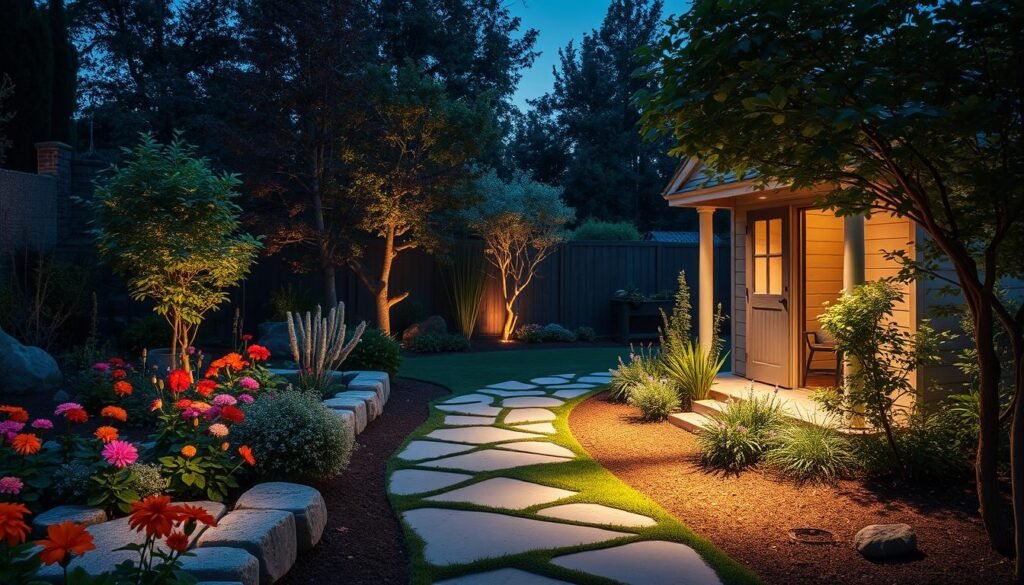
Choosing energy-saving spotlights, like LEDs or solar lights, makes my garden look great. It also helps the planet by using less energy and cutting down on pollution.
Common Spotlighting Mistakes to Avoid
Let’s make your garden lighting perfect. I’ll share some common mistakes to steer clear of. Using too many fixtures can make your garden feel overwhelming. Garden lighting mistakes like this can be avoided by thinking about your garden’s design and needs.
Another error is picking fixtures that are too small. In showrooms, items look 25 percent bigger. To prevent spotlighting errors, choose fixtures that match your garden’s size.
Some common mistakes to avoid include:
- Using too many fixtures
- Not considering the overall design
- Not taking into account the specific needs of your garden
By avoiding these common spotlighting mistakes, you can create a beautiful and functional garden lighting system. It will make your outdoor space even more stunning.
ALSO READ: Spring Outdoor Decor Ideas to Refresh Your Space
Maintenance and Troubleshooting Tips
A well-maintained garden lighting system is a happy one! To keep your lights shining bright, regular cleaning and maintenance are key. This includes checking for damaged or corroded wires, cleaning fixtures, and monitoring wiring for wear and tear.
Choosing the right bulb is important for bulb replacement. LED bulbs are energy-efficient and last longer than traditional halogen bulbs. But, they might cost more at first.
To troubleshoot common issues, consider these steps:
- Check the power source and transformer for any problems
- Inspect the wiring and connections for damage or corrosion
- Look for signs of wear and tear on the fixtures and bulbs
By following these problem-solving solutions and doing regular maintenance and troubleshooting, your garden lighting will keep working well. It will also keep your outdoor space beautifully lit.
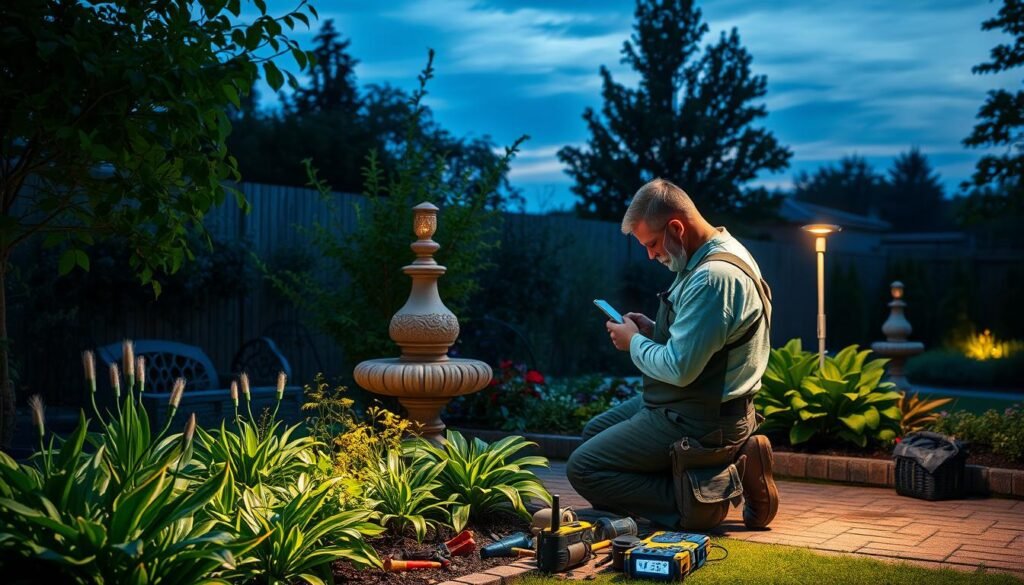
Conclusion: Creating Your Perfect Garden Lighting Scene
As we wrap up our exploration of garden spotlights, it’s time to put everything together. The goal is to create your ideal garden lighting scene. Think about your outdoor space’s design and how it works, mixing useful light with beauty.
Start by looking at your garden and picking out key areas to highlight. LED garden lights are great because they save energy, last a long time, and come in many colors. Place spotlights to make trees, flowers, water features, and sculptures stand out, creating a layered light effect.
The best garden lighting isn’t just about being bright. It’s about making a welcoming and balanced space. Try different light angles and strengths to get it just right. Adding dimmable lights or smart controls can make it even better. With some planning, your garden will become a stunning place that everyone loves.
ALSO READ: Summer Backyard Decor Tips for a Vibrant Look
Frequently Asked Questions
What are the different types of garden spotlights available?
There are many types of garden spotlights. You can find fixed spotlights that shine a steady light. Adjustable spotlights let you change the light’s direction and angle.
How important are light intensity and beam spread in garden spotlighting?
Light intensity and beam spread are very important. They help create the right mood in your garden. The right mix can highlight special features and make your garden look amazing.
What are the different power source options for garden spotlights?
Spotlights can run on different power sources. Solar-powered ones are good for the environment and save energy. Low-voltage spotlights are safe and flexible.
What tools and materials are needed for garden lighting installation?
You’ll need spotlights, cables, and connectors for installation. Choosing the right materials is important for a safe and working system.
How can spotlights be strategically placed to highlight garden features?
Placing spotlights right is key. It helps create focal points and layers light. Getting the distance and angle just right is important for the best effect.
What garden elements can be effectively illuminated using spotlights?
Spotlights can light up many garden features. They work well on trees, flower beds, water features, and sculptures. The right placement can make these features stand out.
What professional techniques can be used to create dramatic lighting effects?
To create stunning lighting, use layering, texture, and color. Also, aim for specific angles and directions. These techniques can make your garden look incredible.
How can garden lighting systems be made weather-resistant?
Making your lighting system weather-resistant is important. Protect the fixtures, manage cables, and adjust for the seasons. This keeps your lights working well for a long time.
What are the benefits of energy-efficient spotlight solutions?
Energy-efficient solutions like LEDs and solar power save energy and cut down on carbon emissions. They keep your garden looking great without wasting resources.
What are some common spotlighting mistakes to avoid?
Avoid using too many lights and not thinking about your garden’s design. Also, don’t forget about your garden’s specific needs. Good planning is key to a great lighting system.
How can garden lighting systems be properly maintained and troubleshot?
Keeping your lighting system in good shape is important. Clean it regularly, replace bulbs when needed, and fix any problems. This ensures your lights work well for years.

